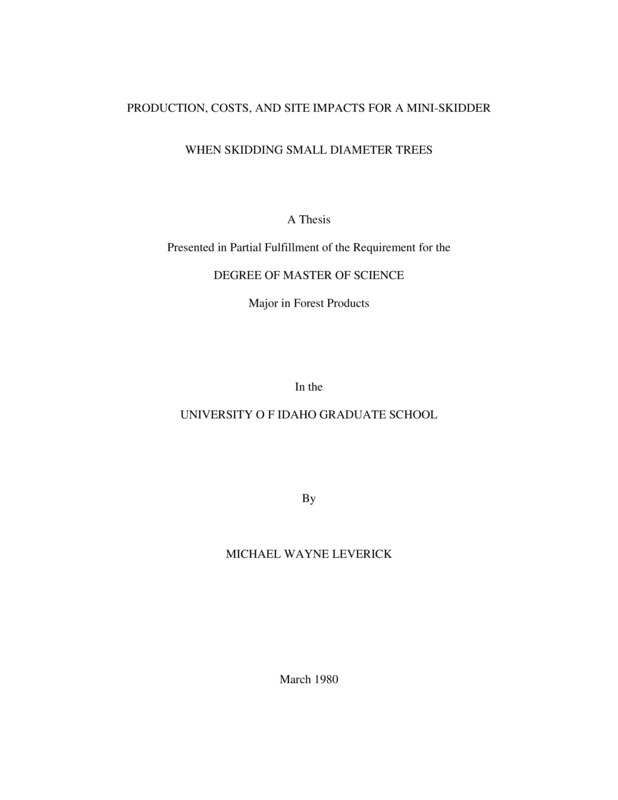PDF PREVIEW
Production, Costs, and Site Impacts for a Mini-Skidder When Skidding Small Diameter Trees Item Info
- Title:
- Production, Costs, and Site Impacts for a Mini-Skidder When Skidding Small Diameter Trees
- Creator:
- Leverick, Michael Wayne
- Date Created:
- 1980-03
- Description:
- An existing small utility machine was modified to work as a small tree and log skidder. Several modifications were necessary to adapt the machine to a timber harvesting situation. The major modifications included design and fabrication of skid plates, grapple boom assembly brackets, grapple, operator and machine safety canopies, and rerouting hydraulic hoses. Cost analyses were made for two cases: (1) skidding thinned material directly to the landing with the small skidder and (2) prebunching thinned material to a main skid trail with the small skidder and moving the material to the landing with either a grapple or choker skidder. These cases were defined in terms of length of skidding distance to the landing. For shorter skidding distances, skidding costs were $177.27 per acre for direct skidding, $144.82 per acre for prebunching and subsequent transport with a grapple skidder, and $214.96 per acre for prebunching and subsequent transport with a choker skidder. For longer skidding distance, skidding costs were $216.66 per acre for direct skidding, $151.64 per acre for prebunching and subsequent transport with a grapple skidder, and $229.47 per acre for prebunching and subsequent transport with a choker skidder. The most important variables affecting turn time in the regression equations included skidding distance on primary and secondary skid trails, and trees and logs skidded per turn. Soil disturbance caused by the small skidder was evaluated in terms of soil compaction and aerial soil surface disturbance. Soil bulk density samples taken during a controlled experiment with soil moisture contents varying from 20.38 to 25.32 percent (%) indicated that soil compaction was limited to within six inches of the soil surface. Soil bulk density samples taken from the most heavily traveled skid trail on the test plot indicated that soil compaction was limited to within the top two inches of the soil surface. The results of the aerial soil surface disturbance study indicated that only 13% of the area was disturbed to a point where erosion could occur as a result of exposed mineral soil. Residual stand damage was evaluated in terms of percent damager by diameter class to the trees of the residual stand. Sapling-sized trees (31.98%) were damaged more heavily than pole-sized trees (17.545%). Use of a herringbone falling pattern helped keep stand damage within acceptable limits. The results of the study showed that a more durable machine is needed in these types of timber harvesting operations.
- Document Type:
- Thesis
- Library Call Number:
- SD388.L4
- Subjects:
- Flat Creek West Hatter Creek soil disturbance soil compaction small skidder grapple skidder chokers cost analysis small diameter trees thinning operations logging residue forest operations
- UIEF Unit:
- Flat Creek West Hatter Creek
- Location:
- UIEF; Flat Creek; West Hatter Creek
- Latitude:
- 46.851013
- Longitude:
- -116.724478
- Department:
- Department of Forest Products
- Type:
- Text
- Format:
- application/pdf
Source
- Preferred Citation:
- "Production, Costs, and Site Impacts for a Mini-Skidder When Skidding Small Diameter Trees", UIEF Research Exchange, University of Idaho Library Digital Collections, https://www.lib.uidaho.edu/digital/uief/items/uief_0017.html
Rights
- Rights:
- In copyright, educational use permitted.
- Standardized Rights:
- http://rightsstatements.org/vocab/InC-EDU/1.0/

